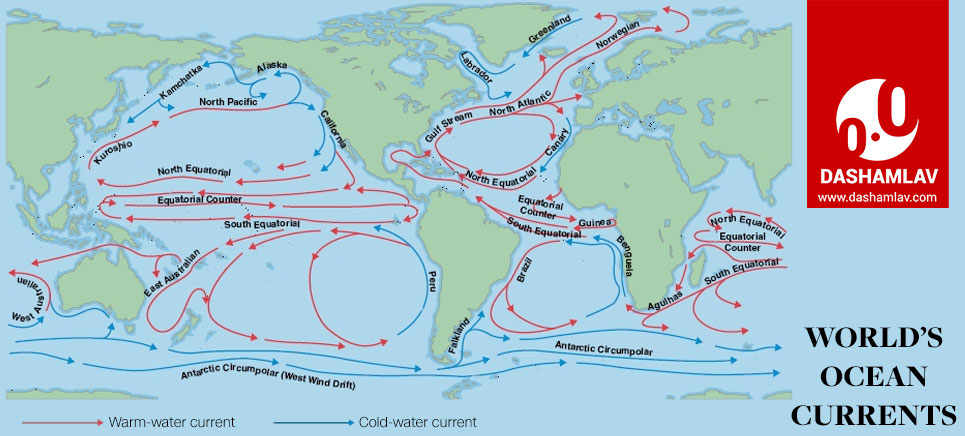Ocean currents represent a regular volume of ocean water moving in a definite path and direction. These currents are primarily horizontal water movements covering large distances. When combined together, the ocean currents create a global conveyor belt which plays an instrumental role in determining the climate of many regions of the world. The ocean currents more specifically influence the temperature of the region through which they travel.For example, because of Gulf Stream Northwest Europe has a temperate climate in comparison to any other region at the same latitude.
A number of forces act upon the ocean water leading to the formation of the ocean currents. This includes both primary and secondary forces like wind, the Coriolis effect, temperature, salinity differences, depth contours, shoreline configurations, and interactions with other currents, etc. All these forces influence the movement and strength of the ocean currents.
What Causes Ocean Currents?
The ocean current is influenced by primary and secondary forces. Primary forces are responsible for initiating the movement of ocean currents. Secondary forces are responsible for influencing the flow of the ocean currents. Some of the major reasons responsible for ocean currents are discussed below.
1. Wind
It is one of the most important drivers of ocean currents. Winds majorly influence the currents that are at or near the surface of the ocean. Near coastal regions, the influence of wind on ocean currents is more localized resulting in phenomena like coastal upwelling. Contrary to this, in the open ocean, winds act as drivers for those ocean currents which circulate water for thousands of miles throughout the ocean basins.
2. Gravity
Gravity tends to pull the water down to pile and ends up creating a gradient variation.
3. Heating by Solar Energy
Heat from the Sun increases temperature of the ocean water and causes the water to expand. This results in a slight gradient due to which water flows in the direction of the slope.
4. Rise and Fall of the Tides
Moon’s gravity causes tides. These high and low tides also produce ocean currents which are called “tidal currents”. These tidal currents are strongest near the shore, bays, and estuaries along the coast. In some places, these currents are so strong that they even can travel up to the speed of eight knots. One of the interesting features of these currents is their predictable nature. They have a regular pattern and can be easily predicted.
5. Thermohaline Circulation
The word thermo means “temperature” and haline means “salinity”. Thus, thermohaline circulation refers to the process which is influenced by density differences. The density difference, in turn, is caused by variation in temperature and salinity.
The ocean currents driven by thermohaline circulation are observed in both shallow and deep ocean. They are comparatively much slower than surface currents or tidal currents.
6. Coriolis Force
The rotation of planet Earth on its axis greatly influences the ocean currents. It results in the development of the Coriolis force which causes the ocean currents to deflect from their path and move towards the right in the northern hemisphere and towards left in the southern hemisphere.

What is Ocean Gyre?
Coriolis force acting upon the ocean water results in large accumulations of water to move in the counter-clockwise direction in the northern hemisphere and clockwise direction in the southern hemisphere. Coriolis force along with wind movements produces large circular oceanic currents. The entire system so developed in the ocean is termed as a gyre.
How many major gyres are there in the world?
There are five major ocean gyres in the world:
- North Atlantic Gyre
- North Pacific Gyre
- Indian Ocean Gyre
- South Atlantic Gyre
- South Pacific Gyre
Characteristics of Ocean Currents
The speed of ocean currents is referred to as its “drift” and it is measured in knots. A fast ocean current is considered strong. Ocean currents are strongest on surface and their strength decreases with depth. Near its surface, the speed of ocean currents is over 5 knots. On the contrary, at depth, it ranges around 0.5 knots.
What is the standard measuring unit of Ocean Currents?
The standard measuring unit of ocean currents is sverdrup (sv).
One sverdrup is equivalent to a volume flow rate of 1,000,000 m3 (35,000,000 cu ft) per second.
Types of Ocean Currents
Ocean currents can be classified in more than one way. The most common classifications of ocean currents are done on the basis of depth and temperature.
Classification on the basis of depth
- Surface Current: It constitutes the upper 400 m of the ocean. It accounts for 10% of all water in the ocean.
- Deep Water Current: It constitutes the entire ocean below the depth of 400 m. It accounts for 90% of all ocean water.
Classification on the basis of temperature
- Cold Currents It is responsible for transporting cold water into warm water regions.
- Warm Current: It is responsible for transporting warm water into cold water regions.
Additional Resource
The below Ted-Ed video by Jennifer Verduin beautifully explains the manner in which ocean currents work.
Use the citation below to add this article to your bibliography
"Ocean Currents of the World: Map, Types, Causes, Characteristics." Dashamlav.com. Web. 26 July 2024. <https://dashamlav.com/ocean-currents-world-map-types-causes-characteristics/>
Dashamlav.com, "Ocean Currents of the World: Map, Types, Causes, Characteristics." Accessed 26 July 2024. https://dashamlav.com/ocean-currents-world-map-types-causes-characteristics/
"Ocean Currents of the World: Map, Types, Causes, Characteristics." (n.d.). Dashamlav.com. Retrieved 26 July 2024 from https://dashamlav.com/ocean-currents-world-map-types-causes-characteristics/
